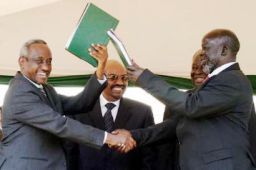Highlights of the Sudan peace accord
NAIROBI, Jan 9 (AFP) — Herewith the main points of the peace accord signed here Sunday between the Sudanese government and the southern rebel Sudan People’s Liberation Movement/Army (SPLM/A), ending Africa’s longest running conflict.

|
|
Sudan’s First Vice President Ali Osman Mohamed Taha (L) and Sudan People’s Liberation Movement leader John Garang show the signed peace accord at a ceremony in Kenya’s capital Nairobi, January 9, 2005. Amid thanksgiving hymns and the dancing of bare-chested warriors, Sudan’s government and southern rebels forged a comprehensive peace on Sunday ending Africa’s longest-running civil war. (Reuters).. |
PROTOCOL ON THE SOUTH’S RIGHT OF SELF DETERMINATION:
According to the protocol on the right of self-determination (known as the “Machakos Protocol”) signed in July 2002, the south will hold a referendum after a six-year transition period to determine whether the region will secede or be part of Sudan.
During the interim period, which starts after six months from the day a final deal is signed, the areas in the south will be exempted from Islamic Sharia law.
PROTOCOL ON POWER-SHARING:
According to a power-sharing protocol signed in May 2004, SPLM/A and the current government in Khartoum will form a government of national unity with a decentralised system of administration. SPLM/A will also set up a separate semi-autonomous administration in the south.
Garang will hold the post of first vice president in the national government and general elections at all levels of government will be held at the end of the third year.
English and Arabic will be the official languages in the country and people from south Sudan will make up 30 percent of the country’s post conflict civil service.
PROTOCOLS ON THE ADMINISTRATION OF NUBA MOUNTAINS AND SOUTHERN BLUE NILE STATE:
According to the two protocols, which were signed in May 2004, disputed regions of Nuba Mountains and Southern Blue Nile will each have their own government headed by a governor directly appointed by registered voters.
An official from either SPLM/A or Khartoum will hold the governor’s post on a rotational basis until elections are held at the end of the third year.
The states will express their views in a “popular consultation” on the final peace deal through their respective elected parliaments.
Any disagreement will be addressed by the national government, while representation in their two assemblies will be: Ruling National Congress Party (55 percent) and SPLM/A (45 percent).
PROTOCOL ON ABYEI STATE:
According to the protocol on Abyei, signed in May 2004, this oil-rich state, currently part of western Kordofan, will be accorded special status under the presidency.
Its residents will be citizens of both Western Kordofan in northern Sudan and Bahr el Ghazal state in southern Sudan and will be administered by a local executive council elected by the residents of Abyei.
International monitors will be deployed to monitor implementation of these agreements in Abyei, while its residents will hold a separate referendum, simultaneous with one in southern Sudan, to determine whether it maintains its special status in the north or will be part of Bahr el Ghazal in the south.
PROTOCOL ON WEALTH-SHARING:
According to the Wealth-Sharing Protocol, which was signed in January 2004, national wealth, notably on revenue from some 250,000 to 300,000 barrels of oil a day produced in southern Sudan, will be shared equally.
Oil revenue from wells in the south, where most exploited petroleum is located, is to be split on a 50-50 basis between the southern and national governments, after at least two percent is given to the states where the oil is produced.
Communities in areas of oil production, which are mostly found in the south, will have a say in extraction contracts. A National Petroleum Commission, comprising officials from both governments, is to be set up to formulate policy and negotiate exploitation contracts.
Half of the non-oil revenue, essentially taxes and levies, collected in the south by the national government is to be allocated to the national government, monitored by a joint commission.
A dual banking system is to be set up, an Islamic one in the north, where charging interest is forbidden, and a conventional one in the south, where a special branch of the central bank will be established.
The central bank is to issue a new currency with a design reflecting Sudan’s cultural diversity.
PROTOCOL ON SECURITY ARRANGEMENTS:
According to Security Arrangements Protocol, which was signed in September 2003, more than 100,000 government troops in southern Sudan and SPLM/A troops deployed in Nuba Mountains and Southern Blue Nile will withdraw under international monitoring, while respecting the north-south boundary drawn in 1956.
Coordination between and command of the two forces will be assumed by a new Joint Defence Board made up of top officers from both sides. Both the government army and the SPLA will remain separate and shall be considered and treated equally as Sudan’s National Armed Forces (SNAF).
During the interim period, the two forces will contribute an equal number of troops to form Joint Integrated Units (JIU) to be deployed on both sides of the border.
The deployment of JIU will be as follows: 24,000 troops in southern Sudan, 6,000 in Nuba Mountains, 6,000 in Southern Blue Nile and 3,000 in the capital, Khartoum.
